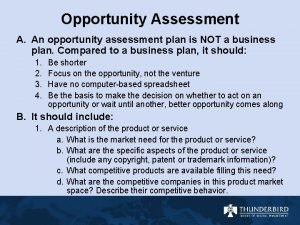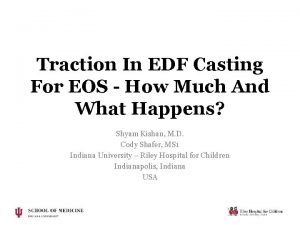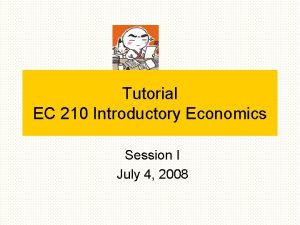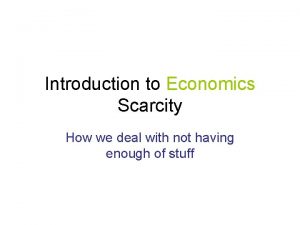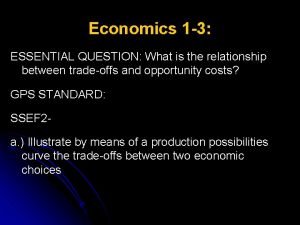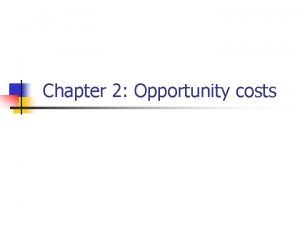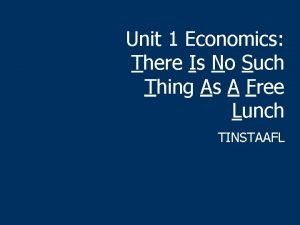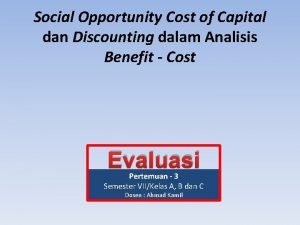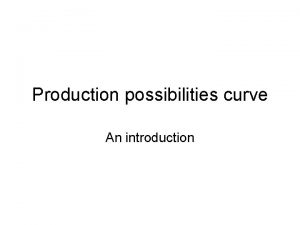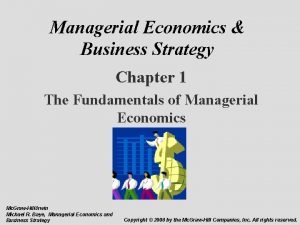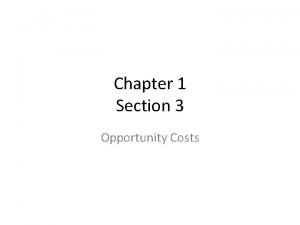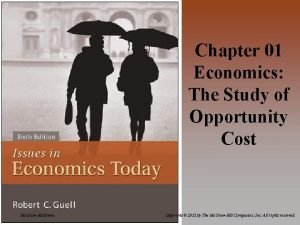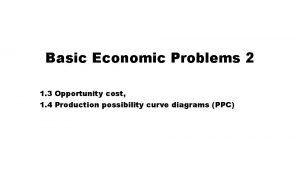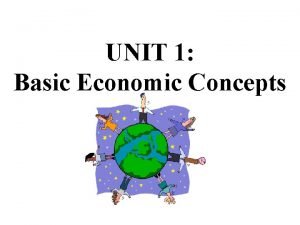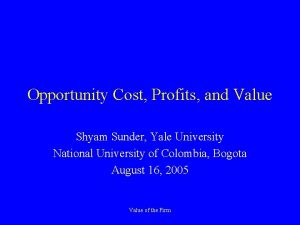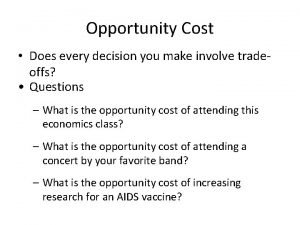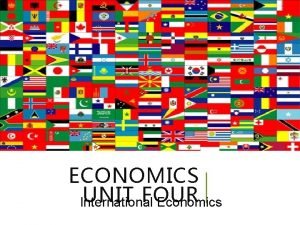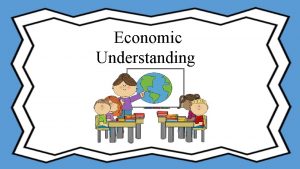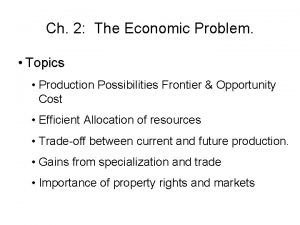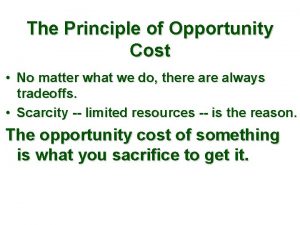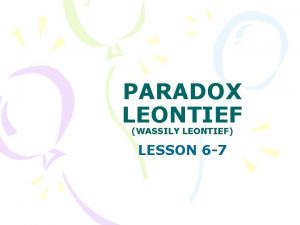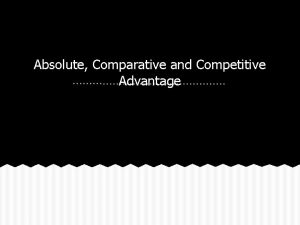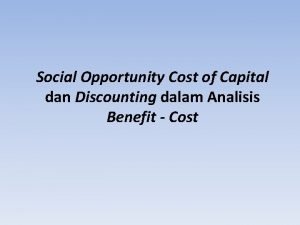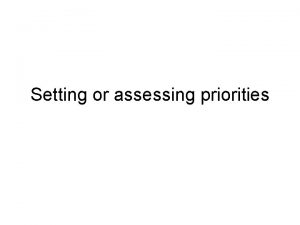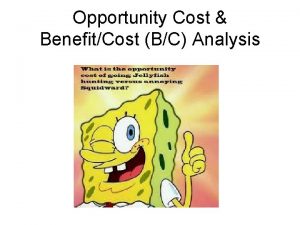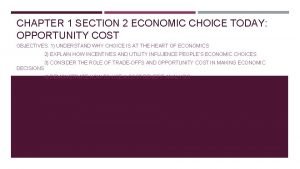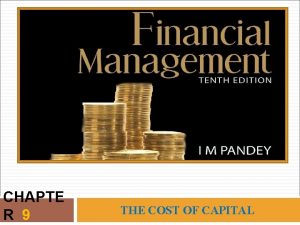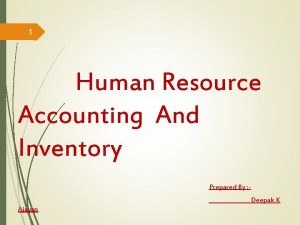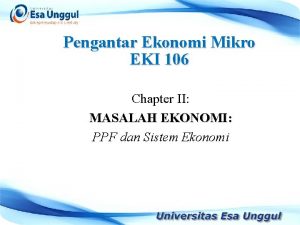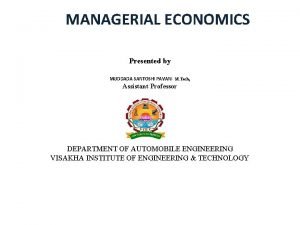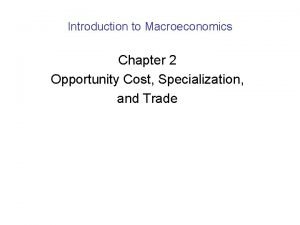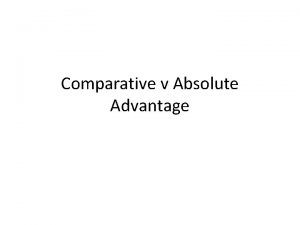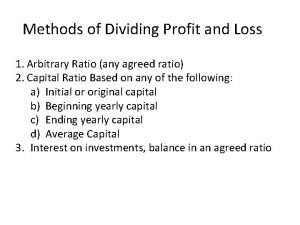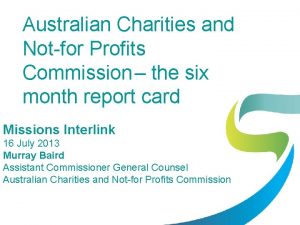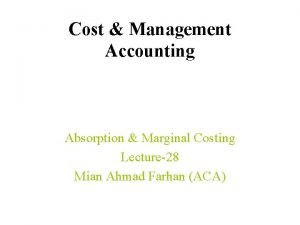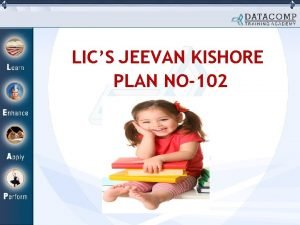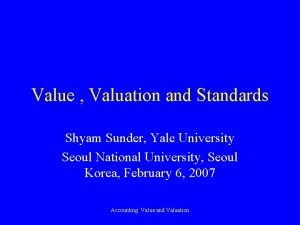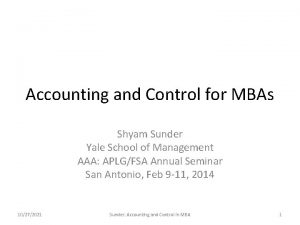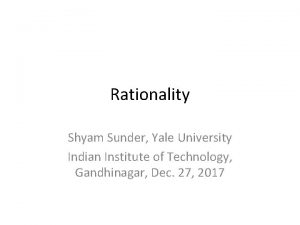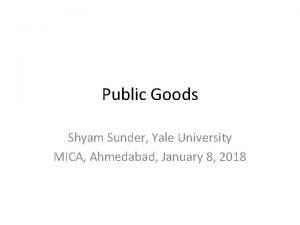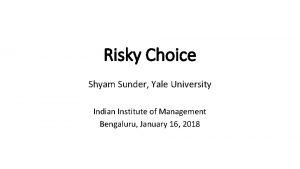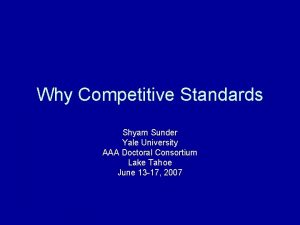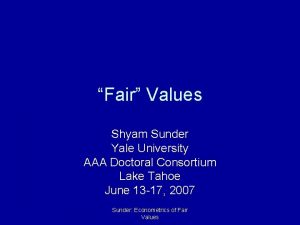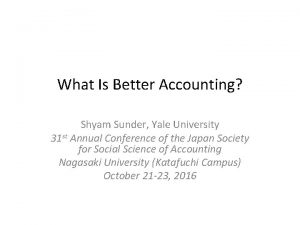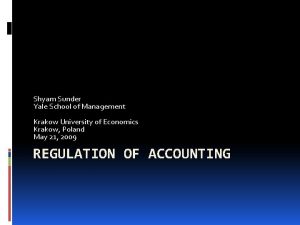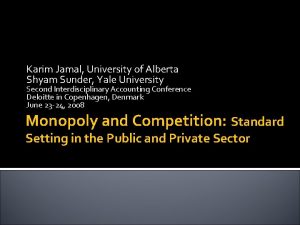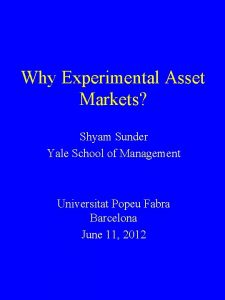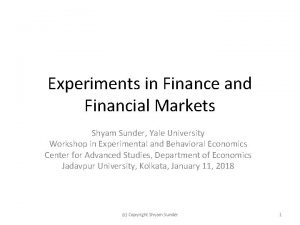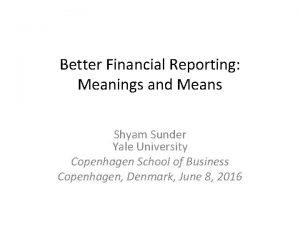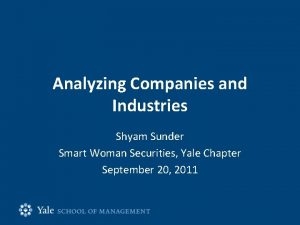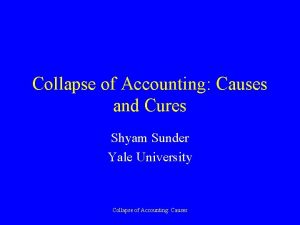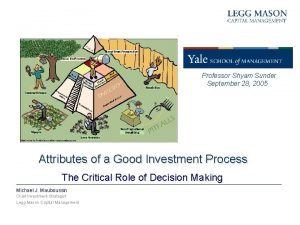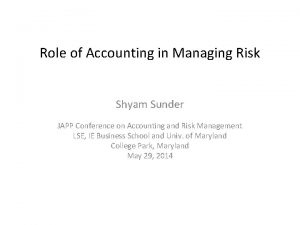Opportunity Cost Profits and Value Shyam Sunder Yale
















































- Slides: 48

Opportunity Cost, Profits, and Value Shyam Sunder, Yale University Zhytomyr State Technological University Zhytomyr May 18, 2006 Value of the Firm

An Overview • Opportunity costs is the concept of cost necessary for economic decisions – Explore its nature and measurement for different kinds of resources • Economic profit, the appropriate criterion for choice, depends on opportunity cost, and different from various agents • Value is the capitalization of profit • Value of the organization can be viewed as the some of the value generated for all participating agents 11/22/2020 Value of the Firm 2

What Is Opportunity Cost? • Sometimes it is easier to understand a concept starting out what it is not • Usually we think of costs as out-of-pocket costs – $1 (cost of a cup of coffee) – $20, 000 (cost of a car) • At the time we make the decision to buy the cup of coffee or the car, this out-of-pocket cost is also (usually) the opportunity cost • With the passage of time, the two tend to diverge from each other 11/22/2020 Value of the Firm 3

Opportunity Costs • How are opportunity costs different from out-of-pocket costs? – Opportunity cost of choosing a decision (e. g. , choosing A over B) is the sacrifice we make by not choosing B – Costs that were never, and would never, be incurred – Subjective, hypothetical (what might have been), speculative and uncertain, must be estimated – Opportunity cost has no existence apart from a decision problem – It is associated with the “road not taken” • Why should such costs count in our decisions? • Let us see a simple example 11/22/2020 Value of the Firm 4

Example of Opportunity Cost • An old painting bought for $5 • You plan to give it to a friend • Just before you give it to your friend, you find out that it is a rare painting by an old master which costs $5, 000 • What is the cost of giving the painting to your friend? 11/22/2020 Value of the Firm 5

More Examples • • Cost of material with no other use Cost of material with other uses Cost of material not yet bought Interest on inventory Cost of labor Cost of capacity Cost of excess capacity 11/22/2020 Value of the Firm 6

Decision with Opportunity Cost • Example illustrates that we can use one of two methods – Calculate the net benefit of each available option and pick the better one – Calculate the net benefit of one option, after subtracting the net benefit of the other option as the opportunity cost • If we calculate correctly, the decision would be the same from both methods of making decisions 11/22/2020 Value of the Firm 7

Opportunity Cost Illustration 11/22/2020 Value of the Firm 8

Contrast with Sunk Costs • One person buys a ticket to see the Olympics final of soccer for 200 dollars • A second person gets the ticket for free from a friend who has an emergency • Severe weather is predicted for the day of the game • Which person is more likely to attend the game? Why? 11/22/2020 Value of the Firm 9

Measuring Opportunity Costs In single person contexts, • use subjective or objective probability to model and solve the decision problem In multiperson contexts, • Absence of objective measures of opportunity costs exacerbates agency costs In either case, reduction in subjectivity of opportunity cost estimates may help make better decisions Perhaps we can use public information to reduce subjectivity in measured opportunity costs 11/22/2020 Value of the Firm 10

How resources behave with time may have to do with the problems of estimating opportunity costs • Cash, being a timeless resource, offers no problems (or perhaps merely because it is defined as the numeraire) • Let us explore the time dimension of resources 11/22/2020 Value of the Firm 11

How Do Resources Behave Over Time? • In acquisition • In expiration of their benefits • In consumption of their benefits 11/22/2020 Value of the Firm 12

Resources Vary in Their Lumpiness or Granularity Along All Three Dimensions • • Let us look at their Acquisition granularity Expiration granularity Consumption granularity 11/22/2020 Value of the Firm 13

Acquisition Granularity Three crude classes: • Low (electrical power, contract labor) – Acquisition and utilization are proximate – Not inventoried, JIT • Medium (groceries) – Economic order quantity (EOQ) Model • High (car, house, machinery and plant) • One-off 11/22/2020 Value of the Firm 14

Determinants of Acquisition Granularity • Transaction costs • Storage costs • Technology of supply 11/22/2020 Value of the Firm 15

Expiration Granularity • • • Same as storability Low (highway sign, receptionist) Medium (bag of sugar, fruit, car) High (gold bar) Note: Distinguish expiration granularity or storability from the rate of expiration of benefits 11/22/2020 Value of the Firm 16

Consumption Granularity (Closely linked to expiration granularity) • Extent of owner's control over the rate of extraction of benefits • Low (street sign, gold ring) • Medium (car) • High (sugar, production gold) 11/22/2020 Value of the Firm 17

Cross Tabulation 11/22/2020 Value of the Firm 18

Decisions • • • Consider a decision List options List resource consequences of options For each resource, consider Acquisition Granularity – If low, OC = purchase price – If high, consider expiration granularity of each relevant attribute of the resource 11/22/2020 Value of the Firm 19

Decisions (Continued) • Expiration granularity – If low, it is a pure capacity resource; Use time as the cost driver, – If high, consider consumption granularity of each attribute of the 11/22/2020 Value of the Firm 20

Decisions (Continued) • Consumption granularity – List driver for each attribute i – For each attribute/driver i calculate cost/unit ci – If a product consumes ui units of attribute i, cost of the resource assigned to the product = maxi (ciui) 11/22/2020 Value of the Firm 21

Example: Rental Car • • • Cost (net of salvage value) = $24, 000 Attribute 1: Time (Capacity 600 days) Attribute 2: Mileage (Capacity 60, 000 m) Time Rate: $24, 000/600 = $40 per day Mil. Rate: $24, 000/60, 000 = $0. 40 per m. Cost of rental = max ($40. Days, $0. 40. miles) 11/22/2020 Value of the Firm 22

Profits • Economic profit of an agent from a decision is the revenue less the opportunity cost of the decision • The profit from participation in an organization can be defined not only for the shareholders but for every participating agent • We can determine who gets how much profit and what is the total profit generated by an organization for all participants combined 11/22/2020 Value of the Firm 23

Neoclassical Firm • Firm is the instrument of the owner- entrepreneur • Every other agent gets the opportunity cost of the resource he/she contributes (i. e. no goodies) – All these factor markets are assumed to be perfectly competitive • All the surplus goes to the owner-entrepreneur • Value of the firm is the discounted present value of cash flows to the owner • IRR = O. C. of capital => zero value 11/22/2020 Value of the Firm 24

Contract or Organization Theory If the total surplus is negative the firm is infeasible; redesign the contracts or shut down • If the total surplus is zero, there is a unique distribution in which everyone gets zero surplus • If the total surplus is positive, there are multiple feasible allocations. There is no basis for choosing one allocation over another. Therefore, the distribution of surplus among agents is undetermined 11/22/2020 Value of the Firm 25

Firm as a Set of Contracts 11/22/2020 Value of the Firm 26

A Brief Detour • • Am I talking about “social accounting? ” Yes, there are some common elements But it differs in perspective Let us do a brief overview of social accounting 11/22/2020 Value of the Firm 27

Social Accounting • Also called socioeconomic accounting, social responsibility accounting and social audit • Measure and report efforts, achievements and impact of firms on “social” dimensions • E. g. , energy conservation, minority hiring, environmental preservation, support of community organizations (see Appendix A) • Often descriptive, may include financial and nonfinancial data 11/22/2020 Value of the Firm 28

Typical Elements of Social Accounts • A. Community Involvement: General philanthropy, Public and private transportation, Health services, Housing, Aid in personal and business problems, Community planning and improvement, Volunteer activities, Specialized food programs, Education, • B. Human Resources: Employment practices, Training programs, Promotion policies, Employment continuity, Remuneration, Working conditions, Drugs and alcohol, Job enrichment, Communications, • C. Physical Resources and Environmental Contributions: Air, Water, Sound, Solid waste, Use of scarce resources, Aesthetics • D. Product or Service Contributions: Labeling, Warranty, Responsiveness to consumer complaints, Consumer education, Product quality, Product safety, Advertising, Constructive research 11/22/2020 Value of the Firm 29

Examples of Social Accounting • Tradecraft, http: //www. globalnet. co. uk/~traidcraft/sa 9495/index. ht ml • British Telecom, http: //www. groupbt. com/society/index. htm • General Motors, http: //www. gm. com/company/gmability/environment/en v_annual_report/index. html • Intel http: //www. intel. com/intel/finance/social. htm • United Airlines http: //www. ual. com/site/primary/0, 10017, 1359, 00. html 11/22/2020 Value of the Firm 30

Social Accounting Perspective • “Social” is construed narrowly, leaves out production, sale and distribution of goods and services, taken for granted • Managers responsible for preparing the social accounts • Information inherently dispersed • Uses perspective of the firm, not the members of society • Fuzzy image 11/22/2020 Value of the Firm 31

Profit/Value of the Firm • • • Extensive income as the sum of: To the shareholders To customers To Vendors To employees To creditors To government To community, etc. Inducement from the firm – O. C. of contributions 11/22/2020 Value of the Firm 32

Profit/Value to Investors • Residual income and corresponding shareholder value created • Focus of current financial reports • Apply similar perspective to other participants in the firm 11/22/2020 Value of the Firm 33

Profit/Value to Customers • Customer’s “investment” in the form of search, learning, negotiation, payments, settlement of disputes • Expected PV of benefits from goods received should exceed the PV of investments • Includes immediate transaction as well as the consequences of the transaction for resource flows associated with any future transactions (reduction in time, cost, search etc. for later transactions) • In a perfect product market, consumer’s surplus from the firm is zero (may be +ve from industry) 11/22/2020 Value of the Firm 34

Value to Government • Various levels of government provide mostly nonpriced services plus some priced goods • Resources from taxation • Value of the firm to the government from providing priced services is the same as for vendors • Value of the firm to the government from providing non-priced services is taxes plus fees minus O. C. of resources spent on providing services 11/22/2020 Value of the Firm 35 • Major challenge to put this in practice

Value of the Firm to Community • Local, national and global • Most exchanges in form of externalities • Value of the firm to the community is the sum of net externalities plus the net payments 11/22/2020 Value of the Firm 36

Measurement of Profit/Value • J. M. Clark (1936): Three fundamental challenges to determining the value of private enterprise – Imperfect and incomplete markets – Fundamental values not as exact as market values – Fundamental concepts should be independent of specific institutions of exchange (generality) 11/22/2020 Value of the Firm 37

Markets and Value of the Firm • In a perfect market Law of one price holds, everyone gets the same price • Value to the supplier of factor is zero • Existence of value =>market imperfection • Perfection can be the tendency of markets under certain conditions, not the goal of any agent • Agents seek and create imperfections (specialization, differentiation, monopolies) • Value creation as a treadmill, not ski lift • Market frictions/trans. Costs create room for value 11/22/2020 Value of the Firm 38

Externalities in Value of the Firm • Difficult problems of measurement because there is no help from markets • Most organizations produce and consume public goods • Extensive concept of income includes the value of these benefits consumed and bestowed on the community 11/22/2020 Value of the Firm 39

Difficulties of Measuring Externalities • Example: Vans to transport employees from train station • Cost of service to the firm, and benefits of lowered costs of parking, absenteeism, morale, etc. • Employee savings: cash, time, fatigue, etc. best estimated by employees • Benefits to fellow commuters, local government, citizens • Lump together as community, apply social cost-benefit analysis to determine income to community • Sensitive to identity of preparer • Valuation: social rate of discount lower than private 11/22/2020 Value of the Firm 40

Implications: Mergers and Acquisitions • Extensive debates surrounding the consequences of corporate mergers and acquisitions • Empirical studies: Target firm shareholders gain, • Acquiring firm shareholders’ wealth effect not clear • Occasional attention to bondholders, and tax consequences • Effects on labor, customers, vendors, community rarely examined • What kind of policy decisions possible on the basis of shareholder value alone? 11/22/2020 Value of the Firm 41

Justification for Shareholder Value Criterion • Assume neoclassical model of the firm (all surplus always goes to the owner, income/value to all other agents is zero both before and after the event): no need to look at the effects on any other class of agents • Capital markets are said to be efficient, at least more perfect than other factor markets • Contradiction between the two assumptions 11/22/2020 Value of the Firm 42

Who Gets the Goodies? • Agents who transact in relatively perfect markets should get prices close to O. C. • U. S. capital markets said to be more perfect than others • Suppliers of capital should be expected to get close to their O. C. • Surplus/value of the firm should accrue mostly to agents who transact through less perfect markets • Yet, we assume that the surplus goes to the shareholders 11/22/2020 Value of the Firm 43

Contract Renegotiation • Shareholders have the only open-ended contract in the firm • All other contracts are periodically renegotiated; these agents try to capture a share of the surplus whenever possible • Short term contract agents have an option value that shareholders lack • Shareholders (as a group) and unvested pensioners cannot quit when faced with having to absorb negative surplus • Many mergers and acquisitions are followed by contract renegotiations 11/22/2020 Value of the Firm 44

Need Analysis of Extensive Income and Values • For policy, need analysis of income/values to all agents, not just shareholders • Given their long term inflexible contract, imperfections in corporate governance, they may not be able to capture all, or even most, of the ex post benefits of value-enhancing mergers and acquisitions • Possible leakage to other agents through market imperfections, holes in corporate governance when value is enhanced • Shareholders left holding the bag on depletion • Would not know without analysis of extensive income/value of the firm 11/22/2020 Value of the Firm 45

Shareholder Value As Guide for Accounting Policy • Event, ERC, Value-Relevance, R 2 studies cited as justifications for accounting policy • What is theoretical justification for using shareholder value for this purpose (other than neoclassical perspective) • Law of the Instrument (Kaplan): Use whatever data is available, extensive income/value measures unavailable 11/22/2020 Value of the Firm 46

Concluding Remarks • Neoclassical perspective is not useful for analyzing many accounting issues • Income and value concepts driven by this perspective have their limitations, and contradictions • For important classes of accounting matters, we may need extensive concepts of income and value • Lessons from national income accounting 11/22/2020 Value of the Firm 47

Thank you • The presentation will be available for downloading from • www. som. yale. edu/faculty/sunder • Please send your comments to • Shyam. Sunder@yale. edu 11/22/2020 Value of the Firm 48
 Shyam sunder meaning
Shyam sunder meaning Difference between opportunity cost and trade off
Difference between opportunity cost and trade off Opportunity recognition and opportunity assessment plan
Opportunity recognition and opportunity assessment plan Edf cast
Edf cast Pigs can't fly shyam selvadurai
Pigs can't fly shyam selvadurai What is trade off in economics
What is trade off in economics Trade off and opportunity cost
Trade off and opportunity cost Trade off and opportunity cost
Trade off and opportunity cost Scarcity, choice and opportunity cost example
Scarcity, choice and opportunity cost example Marginal and opportunity cost
Marginal and opportunity cost Contoh value creation adalah
Contoh value creation adalah Trade-off vs opportunity cost
Trade-off vs opportunity cost Opportunity cost vs trade off
Opportunity cost vs trade off Contoh discounting
Contoh discounting Zero opportunity cost
Zero opportunity cost Opportunity cost in accounting
Opportunity cost in accounting Section 3 opportunity cost
Section 3 opportunity cost Ppf opportunity cost
Ppf opportunity cost Opportunity cost word problems
Opportunity cost word problems Opportunity cost problem example
Opportunity cost problem example Law of increasing opportunity cost
Law of increasing opportunity cost Opportunity cost problem example
Opportunity cost problem example For every decision you make, there is a trade-off.
For every decision you make, there is a trade-off. Law of increasing opportunity cost
Law of increasing opportunity cost Opportunity cost formula
Opportunity cost formula Opportunity cost example
Opportunity cost example Law of increasing opportunity cost
Law of increasing opportunity cost Opportunity cost principle
Opportunity cost principle Teori opportunity cost dari g. harberler
Teori opportunity cost dari g. harberler What is mike's opportunity cost of vacuuming
What is mike's opportunity cost of vacuuming Social opportunity cost of capital
Social opportunity cost of capital Assessing opportunity cost involves
Assessing opportunity cost involves What is it
What is it 4chan
4chan Economic choice today opportunity cost
Economic choice today opportunity cost Book value of debt
Book value of debt What is human resource inventory
What is human resource inventory Definition of scarcity in economics
Definition of scarcity in economics Opportunity cost adalah
Opportunity cost adalah Take home pay
Take home pay Nature of management accounting
Nature of management accounting Time perspective in managerial economics
Time perspective in managerial economics Allocative efficiency vs productive efficiency
Allocative efficiency vs productive efficiency Opportunity cost chart example
Opportunity cost chart example What is andy's opportunity cost of cleaning offices
What is andy's opportunity cost of cleaning offices What is arbitrary ratio
What is arbitrary ratio Australian charities and not-for-profits commission
Australian charities and not-for-profits commission Reconciliation of absorption and marginal costing profits
Reconciliation of absorption and marginal costing profits Jeevan kishore with profits
Jeevan kishore with profits


